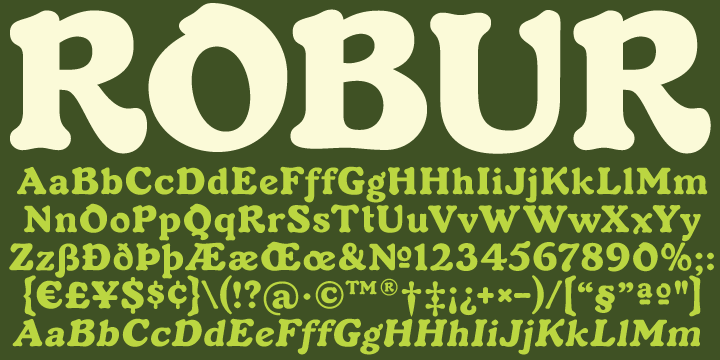What is the Robur™ font?
It shouldn’t be a surprise to anyone that these letter shapes are familiar. They have the unmistakable color and weight of Cooper Black, Oswald Cooper’s most famous typeface from 1921. What should be a surprise is that these letters are actually from George Auriol’s Robur Noir (or Robur Black), published in France circa 1909 by the Peignot foundry as a bolder, solid counterpart to its popular Auriol typeface (1901). This face precedes Cooper Black by a dozen of years and a whole Great War. More…
Cooper Black has always been a bit of a strange typographical apparition to anyone who tried to explain its original purpose, instant popularity in the 1920s, and major revival in the late 1960s. BB&S and Oswald Cooper PR aside, it is quite evident that the majority of Cooper Black’s forms did not evolve from Cooper Old Style, as its originators claimed. And the claim that it collected various Art Nouveau elements is of course too ambiguous to be questioned. But when compared with Robur Noir, the “elements” in question can hardly be debated.
The chronology of this “machine age” ad face in metal is amusing and stands as somewhat of a general index of post-Great War global industrial competition:
– 1901: Peignot releases Auriol, based on the handwriting of George Auriol (the “quintessential Art Nouveau designer,” according to Steven Heller and Louise Fili), and it becomes very popular.
– 1909-1912: Peignot releases the Robur family of faces. The eight styles released are Robur Noir and its italic, a condensed version called Robur Noir Allongée (Elongated) and its italic, an outline version called Clair De Lune and its condensed/elongated, a lined/striped version called Robur Tigre, and its condensed/elongated counterpart.
– 1914 to 1918: World War One uses up economies on both sides of the Atlantic, claims Georges Peignot with a bullet to the forehead, and non-war industry stalls for 4 years.
– 1921: BB&S releases Cooper Black with a lot of hype to hungry publishing, manufacturing and advertising industries.
– 1924: Robert Middleton releases Ludlow Black.
– 1924: The Stevens Shanks foundry, the British successor to the Figgins legacy, releases its own exact copies of Robur Noir and Robur Noir Allongée, alongside a lined version called Royal Lining.
– 1925: Oswald Cooper releases his Cooper Black Condensed, with similar math to Robur Noir Allongée (20% reduction in width and vectical stroke).
– 1925: Monotype releases Frederick Goudy’s Goudy Heavy, an “answer to Cooper Black”. Type historians gravely note it as the “teacher steals from his student” scandal. Goudy Heavy Condensed follows a few years later.
– 1928: Linotype releases Chauncey Griffith’s Pabst Extra Bold. The condensed counterpart is released in 1931.
When type production technologies changed and it was time to retool the old faces for the Typositor age, Cooper Black was a frontrunning candidate, while Robur Noir was all but erased from history. This was mostly due to its commercial revival by flourishing and media-driven music and advertising industries. By the late 1960s variations and spinoffs of Cooper Black were in every typesetting catalog. In the early- to mid-1970s, VGC, wanting to capitalize on the Art Nouveau onslaught, published an uncredited exact copy of Robur Black under the name Skylark. But that also went with the dust of history and PR when digital tech came around, and Cooper Black was once again a prime retooling candidate. The “old fellows stole all of our best ideas” indeed.
So almost a hundred years after its initial fizz, Robur is here in digital form, to reclaim its rightful position as the inspiration for, and the best alternative to, Cooper Black. Given that its forms date back to the turn of the century, a time when foundry output had a closer relationship to calligraphic and humanist craft, its shapes are truer to brush strokes and much more idiosyncratic than Cooper Black in their totality’s construct.
Robur and Robur Italic come in all popular font formats. Language support includes Western, Central and Eastern European character sets, as well as Baltic, Esperanto, Maltese, Turkish, and Celtic/Welsh languages. A range of complementary f-ligatures and a few alternates letters are included within the fonts.
Robur™ Font families
The Robur™ includes the following font families:
- Robur
- Robur Italic
Robur™ Preview
Here is a preview of how Robur™ will look. For more previews using your own text as an example, click here.

